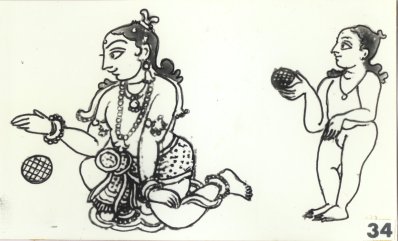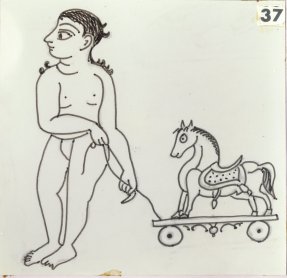Education of Royalty
In modern times, wherein most countries claim to have adopted a democratic form of government, it is difficult to predict who will head the government after an election. As a result of the power of the ballot, in the twentieth century, farmers and housewives have been elevated to the status of the governing elite and have ruled nations. Although such leaders lack the intensive training expected of a thoroughbred administrator, several committees of experts are formed in order to help steer the administrator out of trouble, and no vacuum is felt even if at times the leader is incompetent. In the days of yore, however, when monarchy was the order of the day, every care was taken to train the future king in different fields. The crown prince and his brethren, who also ruled as governors of different provinces of the kingdom, received rigorous and multi-disciplined training for ten to fifteen years. Ancient classics and inscriptions of Karnataka do provide glimpses of the training the princes received in martial arts, diplomacy, the arts, crafts and sciences and especially in the science of polity or politics.
© K. L. Kamat

Picture 34: Ball Games
We see that the princes, although brought up in palaces amidst luxury, enjoying utmost care and attention, shared the sports of commoners. Ballgames and pebble-games were popular (see pictures 34 and 35).Games with the bagari (stringed top) entertained the youngsters (see picture no. 36) for hours on end. Wooden animals on wheels attracted the children of the rich and the poor alike (see picture no.37).
© K. L. Kamat

Picture 37: Boy Playing with a Wooden Horse
Literary education started between the ages of five and eight years, soon after the initiation (see: upanayana) ceremony, on an auspicious day. A seat and a board were then provided to the child prince. The royal preceptor or guru taught the alphabet (see picture no.38). Corporal punishment or even a scolding could not be meted out to the future king and yet the teacher was expected to successfully train the prince in various subjects. It was no doubt a tough job for the teacher, who tried to educate the princes in the rudiments of all shāstras, arts, and applied sciences. Physical education also started at a tender age. This was a stepping-stone towards later mastering the martial arts, which eventually enabled youngsters to master full-fledged military science.
Dueling with small swords and light maces was taught using techniques designed to make the prince alert and quick. Footwork was as important as the grip for the hands. The use of bows and arrows predominated, because archery was considered the epitome of military training. It involved sharp vision, concentration, a steady gait, alertness, quickness of foot- and hand-work, agility, and in short, all around physical strength. Various methods of using the bow, sword, dagger and mace were practiced.
According to the poet Pampa, his patron Arikesari studied the following:astronomy, astrology, grammar, figurative speech, the epics, dharmashāstras, darshanas (systems of philosophy), nātyashāstra (dramatics) elephant- and horse-lore, painting, archery, the science of jewels, architecture, antidotes against poison ( vishāpaharana or toxicology), erotica, technical education (yantra), and the science of warfare. Since the king was expected to mastermind the whole administration, and preside over many expert committees and provide his own conclusions, he was expected to know about all the existing formulae in statecraft, which required a wide range of general knowledge. Besides, some monarchs developed particular talents. Kannada inscriptions provide examples of different kings who were proficient in drama, bharata (dramatics), the purānas, dancing orplaying instrumental music. The Ganga king Satyavakya (also called Narasimha) was adept in these fine arts.
Training in Leadership
The Manasollasa itself forms a guidebook for kings, and naturally lists the topics that a prince had to study compulsorily. A strong and well-built body was essential, and learning several arts ( kalākaushalam) was as important as the mastery of shāstra (science) and shastravidyā (the wielding of weapons). The king appointed highly specialized teachers to teach these subjects and periodically examined the princes on their progress, with the help of experts and upādhyāyas (teachers). The instructors were well rewarded, with grants of villages and townships, clothes, gold and lands.
Public speaking received due attention during training, as the king was required to address his subjects and conduct meetings with different committees frequently. The focus was on correct pronunciation, on how to place stress on the right words, and on determining the appropriate speed for delivering an address. The art of conversation, debate, and repartee were as important as attentive listening, quoting and reciting. The recitation of poetry and poetical repartees ( kāvyashāstravinoda) were a favorite pastime , and the talented princes often presented their own compositions at such meets. Public polemics1 were quite common, and the king had to preside over assemblies of learned people. The palace staff prepared well for such occasions so that the future king did not cut a sorry figure!
Hunting
Hunting was prerequisite training on the way to mastering the martial arts. Several princes greatly relished these hunting ( shikār) expeditions and some in fact did have a weakness for the sport. As addictive hunting was considered one of the seven vices that a king had to avoid, care was taken to prevent the princes from becoming a prey to the game of hunting. Elaborate arrangements preceded hunting expeditions. Firstly, various types of nets, tools, weapons, tents, trained dogs, hawks, cheetahs, deer and expert hunters were gathered. Hunting activity ranged from chasing harmless rabbits and deer, to killing dangerous beasts such as lions, tigers, bears, boars, and bison. The princes learnt a good deal about forest life, including the natural habitats of beasts, about flora and fauna, as well as about the hiding places of different animals. Princes were tested for a sound knowledge of wild life and surroundings. Inscriptions eulogize the expertise of several kings in wielding weapons and killing wild animals. After giving a wide margin to accommodate all the exaggeration, one can surmise that the royalty had to exercise a high standard of aiming and shooting, a great presence of mind, and was at all times to display precaution and alertness.
It is important to note here that women of the palace also took part in hunting expeditions on horseback, as attested to by poet Bilhana and the Manasollasa. After each expedition, youngsters grew in the knowledge of life in the wilderness and ecology. They returned tougher, more daring and cautious after these forays into the wild.
Traveling also formed an important part of the princes' education. Frequent travels to remote parts of one's own country and friendly neighbors' regions brought the princes in direct contact with the masses. At times, they went disguised as pilgrims and thereby obtained first hand information about the state of things in their kingdoms. They also visited holy places throughout the subcontinent whenever possible, and this practice undoubtedly helped teach geography, topography and about the overall culture of the land.
Military training and management skills were put to the test when the princes were sent to suppress a rebellion or conquer new principalities. They were encouraged to accomplish all this without shedding blood or permitting looting. When the expedition was successful, the victory was celebrated with great pomp and gaiety in the capital.
From the details of the daily routine of Krishnadevaraya of Vijayanagar provided by the Portuguese traveler Domingo Paes, and also from the Telugu classic Amuktamalyada ascribed to that king himself, we learn that a good part of the morning was spent by the king in physical exercises such as wrestling and horse riding2. Of course, the king himself led most of the important military expeditions. The early years of rigorous training were useful in the later years of holding the highest office in the land.
Scholarly rulers
Not all princes could become a Vikramaditya, a Krishnadevaraya or a Tippu Sultan. "Obedient, brilliant, learned sons skilled in warfare, are begotten only by Sukrita!" (sukrita is merit earned in previous life), exclaims the king Someshwara in Manasollasa, suggesting that such princes were indeed rare3. However, all effort was made to make the future king versatile, and some did exhibit their talent in different fields. The author of Manasollasa was a great musicologist and musician. Chalukya Vikramaditya VI had mastered several languages and scripts besides oratory. King Jayasimha was a critical examiner of poems and dramas. Hoysala king Narasimha was sāhitya sarvajna (master of literature). The Silahara king Apararka wrote a commentary on the Yajnavalkya Smriti, and Chikkadevaraya of Mysore had attained mastery in playing theveenā4.
The education of Belavadi Mallamma, a princess of the Sonda kings of Karanataka, deserves special note and is described in an appendix to this book (see Appendix A).
By and large, one can say that the royalty and nobility of medeival times in Karnataka were well trained in military science; for them, sports and games opened the portals of that science. Neetishāstra (the principles of governance) was for the rulers a compulsory subject. The Agni Purana lays down that the king who subjugates his senses should learn the sciences of logic and punishment, and acquire a special knowledge of the commercial undertakings of the world, because only then is he able to keep his subjects under control. It is thus clear that the science of economics and the principles of trade and commerce formed an essential part of a prince's study along with military science. However, there were no watertight compartments in the curriculum as in modern times. The courses were flexible enough to accomodate all aligned subjects underNeetishāstra or Rājaneeti.
References
- Manasollasa II, verses 199-200, p. 171.
- Sewell, p. 261.
- Manasollasa II, verses 1298-1300, p. 111.
- Chikkadevaraya Vamsavali p. 101-102

